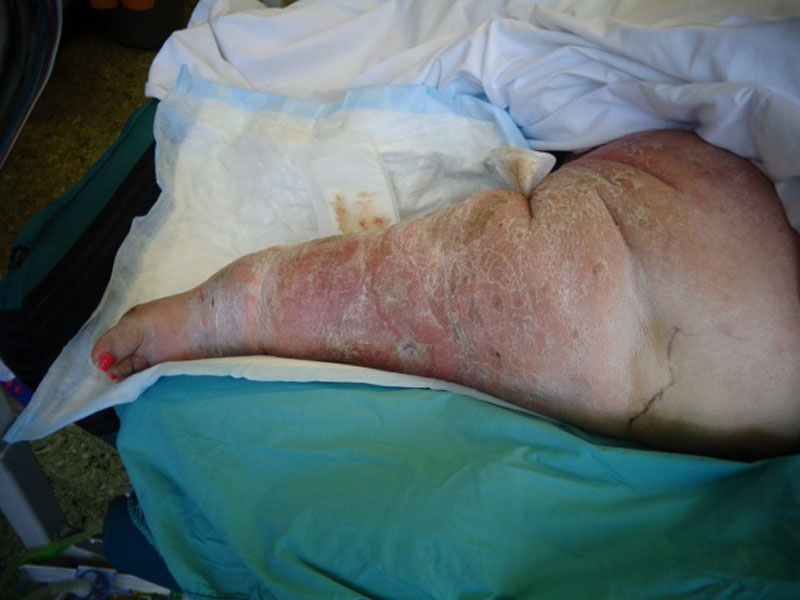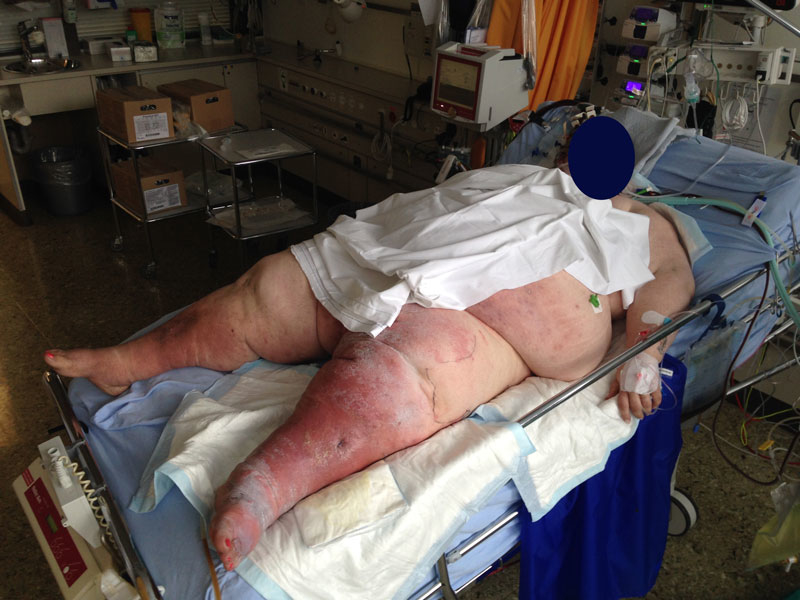
Figure 1 The bullous erysipelas
DOI: https://doi.org/10.4414/smw.2018.14639
For patients with worsening hypercapnia, there are various ways to remove CO2. One is noninvasive ventilation. There are circumstances, however, where noninvasive ventilation fails. In special populations, such as morbidly obese patients, the solution to failed noninvasive ventilation is not necessarily intubation and subsequent mechanical ventilation, as this puts the patient at risk of ventilation-induced lung injury or pneumothorax. Consequently, this case involves venovenous extracorporeal membrane oxygenation (ECMO) as a means of hypercapnia reduction. It is intended to be an alternative to intubation and mechanical ventilation. Venovenous ECMO as an alternative to intubation, as described in several studies and case reports, has demonstrated its potential in similar situations before [1–6]. Although venovenous ECMO is known for potential complications, this case demonstrates that the benefits may outweigh the treatment-associated risks in particular populations.
A recent systematic review and meta-analysis came to the conclusion that medical complications of venovenous ECMO frequently occur, but their effect on mortality is limited [1], hence justifying its application in acute respiratory distress syndrome (ARDS). A retrospective study on obese and extremely obese patients with respiratory failure concluded that neither mortality, nor the number of complications was associated with body mass index (BMI) [2].
A study involving more than one hundred consecutive patients with ARDS receiving venovenous ECMO drew a similar conclusion [3]. They found that obesity in terms of BMI was not associated with increased mortality. In contrast, morbidly obese patients had the lowest mortality rates in their analysis. The finding that higher BMI is not related to higher mortality was also revealed in a single-centre review of 55 patients with ARDS [5]. In this study, the group of most obese patients (six patients with an average BMI of 57.3 kg/m2) had a 100 percent survival rate [5].
A recent case report presented a patient with a BMI of 60.2 kg/m2 who suffered from obesity hypoventilation syndrome and fluid retention [4]. Because of the high mortality rates for mechanical ventilation in this patient population, the authors applied venovenous ECMO as an alternative to reducing CO2 by intubation and subsequent mechanical ventilation. The respiratory support applied was through venovenous ECMO and eventually resulted in successful CO2 elimination. In the meantime, weight loss was initiated following the administration of diuretics [4]. In addition, two cases of successful recovery were reported for morbidly obese patients (BMI 47 kg/m2 and 93 kg/m2) with ARDS due to aspiration [6].
Although these examples exist, the evidence regarding venovenous ECMO as a means of CO2 removal in this population of patients is limited. The present case also involved obesity hypoventilation syndrome and hypercapnia. The case was further aggravated by multi-organ failure as a result of sepsis with altered mental state (obtundation) and acute anuric kidney failure.
A 33-year-old female patient with morbid obesity (BMI 84 kg/m2) was transferred to our intensive care unit from another intensive care unit. She had been admitted to the first intensive care unit because of sepsis due to bullous erysipelas of the lower left extremity (fig. 1). In the course of treatment, she developed acute anuric kidney failure and was dependent on continuous venovenous haemodiafiltration. The reasons for referral to our intensive care unit were failed noninvasive ventilation attempts and continuous hypercapnia. The patient arrived at our intensive care unit in an obtunded state of consciousness with a pH of 6.96, pCO2 15.1 kPa, oxyhaemoglobin 94.6%, base excess −6.5, HCO3 − 25.6 mmol/l. Due to the expected complications of mechanically ventilating the patient, the decision to institute venovenous ECMO was made (fig. 2). Venovenous ECMO helped to successfully remove CO2. Subsequently, the patient could be weaned from the ECMO, which was disconnected after 8 days. No bacteria were isolated from blood cultures, but a biopsy of the bullous erysipelas revealed Serratia marcescens, which responded well to treatment with meropenem. The kidney function improved within 5 days of continuous venovenous haemodiafiltration. The patient was successfully transferred to a nearby rehabilitation centre. She gave her informed consent to discussion of her case in the scientific literature.

Figure 1 The bullous erysipelas

Figure 2 Applying venovenous extracorporeal membrane oxygenation for CO2 removal as an alternative to mechanical ventilation. The patient gave her informed consent to this publication including anonymous pictures of herself.
What is special about this case is that we are not aware of a more critically ill patient who survived. Our patient had a pH of 6.96, sepsis and multi-organ failure including acute anuric kidney failure and altered mental state (obtundation). These factors contribute to a high mortality. In addition, the BMI of our patient was one of the highest reported in the literature of patients treated with ECMO [1–6]. Hence, percutaneous cannulation was particularly challenging, but possible. It confirms previous publications that have reported that, once the respiratory problem is solved through venovenous ECMO (hence imminent death was avoided), the other organs will have a chance to recover.
In special circumstances, the benefits of venovenous ECMO presumably outweigh the treatment-associated risks and complications. At first sight, one might be tempted to intubate and mechanically ventilate the patient for the purpose of CO2 elimination, especially if noninvasive ventilation fails. In morbid obesity, however, mortality rates for intubated patients are high. In addition, we would have faced the risk of ventilation-induced lung injury, pneumothorax or other barotrauma when applying pressures high enough to inflate the lungs sufficiently, particularly in our patient with a BMI of 84 kg/m2. The relatively fast recovery of our patient suggests venovenous ECMO as a means of CO2 removal should be considered as an alternative to intubation in this patient population. There is limited evidence in the literature, but recent findings suggest that obesity is not associated with higher mortality when applying venovenous ECMO [2, 3]. A few words of warning need to be issued, though. When installing venovenous ECMO in morbidly obese patients, one should pay a great deal of attention to percutaneous cannulation, which can be challenging as a result of hard skin covering the adipose tissue and a long path to central venous access. Consequently, it should be installed by physicians who are sufficiently experienced in venovenous ECMO. As suggested elsewhere [4], the neck and femoral regions can be prepared for cannulation by applying adhesive tape, which temporarily removes curvatures and wrinkles caused by the adipose tissue underneath the skin [4].
Like mechanical ventilation, ECMO is not without risks. Although mortality was not increased relative to nonobese patients [2, 3, 5], mortality due to complications occurs [1]. Complications are mostly related, but not restricted, to bleeding (including cannula bleeding, intracranial haemorrhage). Other complications include cannula infections [1], oxygenator clotting [2], thrombosis [1, 5], pneumothorax [1] and heparin-induced thrombocytopenia [5]. Although the avoidance of mechanical ventilation reduces the risk of barotrauma and consequent pneumothorax, cannulation to install venovenous ECMO also bears the risk of pneumothorax [1]. Although omission of mechanical ventilation excludes the risk of ventilation-associated pneumonia, aspiration due to somnolence or cannula infections are possible in venovenous ECMO. As a result, it is necessary to carefully weigh the risks and benefits before deciding in favour of venovenous ECMO in morbid obesity.
Raoul Sutter received research grants from the Swiss National Foundation (No 320030_169379), the Research Fund of the University Basel, the Scientific Society Basel, and the Gottfried Julia Bangerter-Rhyner Foundation. He received personal grants from UCB-pharma and holds stocks from Novartis and Roche.
1 Vaquer S , de Haro C , Peruga P , Oliva JC , Artigas A . Systematic review and meta-analysis of complications and mortality of veno- venous extracorporeal membrane oxygenation for refractory acute respiratory distress syndrome. Ann Intensive Care. 2017;7(1):51. doi:.https://doi.org/10.1186/s13613-017-0275-4
2 Swol J , Buchwald D , Strauch JT , Schildhauer TA , Ull C . Effect of body mass index on the outcome of surgical patients receiving extracorporeal devices (VV ECMO, pECLA) for respiratory failure. Int J Artif Organs. 2017;40(3):102–8. doi:.https://doi.org/10.5301/ijao.5000572
3 Lazzeri C , Bonizzoli M , Cianchi G , Batacchi S , Terenzi P , Cozzolino M , et al. Body mass index and echocardiography in refractory ARDS treated with veno-venous extracorporeal membrane oxygenation. J Artif Organs. 2017;20(1):50–6. doi:.https://doi.org/10.1007/s10047-016-0931-8
4 Umei N , Ichiba S . Venovenous Extracorporeal Membrane Oxygenation as a Treatment for Obesity Hypoventilation Syndrome. Case Rep Crit Care. 2017;2017:9437452. doi:.https://doi.org/10.1155/2017/9437452
5 Kon ZN , Dahi S , Evans CF , Byrnes KA , Bittle GJ , Wehman B , et al. Class III Obesity is Not a Contraindication to Venovenous Extracorporeal Membrane Oxygenation Support. Ann Thorac Surg. 2015;100(5):1855–60. doi:.https://doi.org/10.1016/j.athoracsur.2015.05.072
6 Kadakia S , Ambur V , Moore R , Toyoda Y , Shiose A . Venovenous Extracorporeal Membrane Oxygenation in Two Morbidly Obese Patients. Gen Thorac Cardiovasc Surg. 2017;65(10):594–7. doi:.https://doi.org/10.1007/s11748-016-0740-2
Heidi Lederer, Magnus Stalder, Kai Tisljar (these authors contributed equally to the manuscript).
Raoul Sutter received research grants from the Swiss National Foundation (No 320030_169379), the Research Fund of the University Basel, the Scientific Society Basel, and the Gottfried Julia Bangerter-Rhyner Foundation. He received personal grants from UCB-pharma and holds stocks from Novartis and Roche.